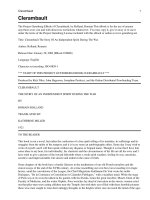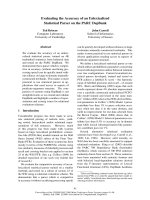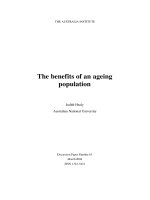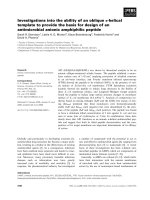03 the organization of an essay
Bạn đang xem bản rút gọn của tài liệu. Xem và tải ngay bản đầy đủ của tài liệu tại đây (183.42 KB, 8 trang )
The Organization of an Essay
The following explains the traditional way to organize an expository essay that is trying to make
a point about some topic and to provide supporting material for that point. This method of
organizing may vary slightly depending on the specific type of essay that you are writing.
***
Title of Essay
The title of the essay reveals the
general topic of the paper and gives
some indication of the particular point
being made about that topic.
The thesis statement goes here. This
is one sentence which summarizes the
main point that the entire essay is
making.
The first body paragraph will state
and explain the first reason in support
of your thesis.
The second body paragraph will
state and explain the second reason in
support of your thesis.
The third body paragraph will state
and explain the third reason in
support of your thesis.
The concluding paragraph begins
with a repeat of the thesis statement
but with slightly different wording
from the first version of the thesis
statement.
07-16-08-2d
The Introductory Paragraph: A Closer Look
The purpose of the introductory paragraph in an essay is to “introduce” the reader to your topic
in a gradual and logical manner. The introductory paragraph gently “eases” into the topic so that
the reader can follow your train of thought and be better prepared for what you will be saying
later in the essay. The introductory paragraph usually ends with the thesis statement, which is
one sentence that sums up the one, main point that your essay is making about its topic.
Here are some specifications about the typical introductory paragraph:
• It begins with an indentation (as do all the paragraphs in your essay)
• It is not too long or too short --usually about four to five sentences long.
• It should begin with an “attention grabber,” i.e., something that will capture and keep the
reader’s attention and make him want to continue reading your essay.
This device could be:
a. an interesting or unusual little-known fact about your topic
b. a thought-provoking rhetorical question
c. a brief narrative (a little story) which illustrates a point related to your topic
• It begins with a rather general tone and gradually gets more specific toward the end.
• It usually ends with your thesis statement, which might also contain a brief summary of the
supporting reasons (often three or more) for your thesis. This
• thesis statement should contain some of the same important words as the title of your essay.
The following is a sample introductory paragraph that demonstrates the points mentioned above:
Attention Grabber
The Need for Parental Controls of TV Programs
Title
Statistics show that there are more television sets in America than bathtubs. The average
American home has at least two TVs. Something else that the average American home has is
children—and often very young, impressionable children. This combination of children and
television can be good (as with educational programming like National Geographic), but it can
also be quite damaging (as with programs depicting excessive sex and violence like CSI: Special
Victims Unit). Clearly there needs to be some type of regulation of what young children see on
their TVs at home. Parents should definitely monitor, screen, and control the types of TV
programs that their young children watch.
Thesis Statement
(The essay would then go on to present at least three specific reasons why the author of the essay
feels that parents should control what their children watch on TV. Each reason would be fully
explained in its own paragraph, and therefore the body of the essay would contain three
paragraphs.)
07-16-08-1b
The Body of the Essay
The following information about the body of an essay applies to all types of essays in which you
are trying to make a point about something and support it.
The body of the essay is the part between the introduction and the conclusion. It is the longest
and most important part of the essay, because its purpose is to provide support for your thesis
statement. This support can come in the form of examples, facts or statistics, short narratives
about the personal experience of the author, or simply more details explaining what you mean.
Usually the body of an essay contains at least three paragraphs and often more. Each paragraph
discusses one idea that supports your thesis statement. For example, if you have four main ideas
to support your thesis statement, then four paragraphs will be in the body of your essay – one
separate paragraph to discuss each idea. These supporting paragraphs can be as long or as short
as necessary, but the average length is usually about five or six sentences.
Your body paragraphs should be arranged in increasing order of importance. That means to
begin by explaining the supporting idea that is only slightly important and end with the
supporting idea that is VERY important.
When you begin each new body paragraph, you should use a transition, which could be one
word, a phrase, or even a full sentence. A transitional word would be something like First,
Secondly, Thirdly, Next, or Finally. Sometimes slightly longer phrases can be used such as In
the first place, On the other hand, or By contrast.
NOTE: The first transitional word or phrase would be used at the very beginning of the second
body paragraph and would appear at the start of the first sentence of each body paragraph after
that one until you get to the concluding paragraph.
The purpose of the transition is to remind the reader of your paper about the main idea of the
previous paragraph before he begins reading the new paragraph. Do not use a transition at the
end of one paragraph to tell the reader what the next paragraph is going to be about. In other
words, a properly used transition would remind the reader of what has already been said in the
previous paragraph, not what is going to be said in the next paragraph. It’s a review of the past,
not a prediction of the future.
07-21-08-1a
The Concluding Paragraph of an Essay
The concluding paragraph of an essay is almost as important and as carefully structured as the
introductory paragraph. Here are some general pointers about a properly written concluding
paragraph:
• The first line should be indented (just like all the other paragraphs).
• The concluding paragraph should not be too long or too short; the average length is about four
or five sentences.
• The concluding paragraph should begin with a repeat of the thesis statement (main idea) of the
essay but with slightly different wording from the original thesis statement in the introduction.
• The main purpose of the concluding paragraph is to sum up the major ideas of the essay by
reviewing the important points that have been made and by reminding the reader what the
main point (the thesis statement) of the essay was.
• No new information or new ideas should be in the conclusion.
• If possible, the concluding paragraph should end on a positive, upbeat note.
• It is not necessary or desirable to begin the concluding paragraph with the trite phrase, “In
conclusion,…” There are better phrases to use to imply that this is the concluding paragraph of
the essay.
Here is a sample concluding paragraph that exemplifies the above traits:
Repeat of thesis
First reason
Second reason
It is clear, then, that responsible parents have a definite obligation to monitor their
children’s TV watching. First of all, from an educational standpoint, parents could help their
children learn better by urging them to watch educational programs that relate to the topics that
the children are studying in school. Secondly, it is the civic responsibility of parents to help their
children grow up as law-abiding, dependable members of society. Finally, and perhaps most
importantly, parents have an ethical responsibility to ensure that their children become moral,
decent adults. By keeping a careful and loving eye on what their children watch on TV, parents
can make television time a pleasant family experience.
Third reason
Positive ending
07-17-08-2b
Trip Through Transitions
A transition is moving from one place to another. In writing, we try to make transitions between
paragraphs so that the reader of our paper can “move” smoothly from one idea to another. The
transitions help show how the various ideas are related to each other.
A transition is usually placed at the START of a new paragraph in the body of the paper. Do not
place it at the end of the previous paragraph; it goes at the very beginning of the NEW
paragraph.
The transition could be anything from a single word to an entire sentence. Many times,
transitional phrases are already well known, such as Consequently, On the other hand, In
contrast, By the same token, Along the same lines, and others. At other times, you will have to
create an entirely new sentence in order to make your transitional thought.
Here is a diagram to show where transitional phrases usually go in the average essay:
__ __ __ __ __ __
Intro
Body Paragraph I
Transitions
Xxxxxx xxx xxx xxxxxxx xxxxxx xxxx
xxxxxx xxxxxx.
Body Paragraph II
Xxxxxx xxx xxx xxxxxxx xxxxxx xxxx
xxxxxx xxxxxx.
Body Paragraph III
07-07-08-1a
A Trip Through Transitions
1. Additional information of the same nature as what has just been given.
and
Similarly,
Likewise,
In the same way,
Moreover,
Furthermore,
Just as . . . , so also . . . . .
Also,
In addition, . . .
By the same token, . . . .
Along the same lines, . . . .
2. Opposite or contradictory information from what has just been given
but
However, . . . .
Although . . . . . .
On the other hand, . . . .
In spite of this, . . .
Nevertheless, . . .
Nonetheless, . . .
On the contrary, . . . .
By contrast (or In contrast, . . .)
3. A choice between two options
or
either . . . or (one of two things or people mentioned)
neither . . . nor (no choice of two things mentioned)
if . . . ., then . . . . .
4. A reason for some occurrence or some course of action
because
by reason of . . .
due to . . .
(Avoid “due to the fact that . . . .” Just use because instead.)
5. Coming to or drawing a conclusion; “finishing up.”
then
therefore
thus
hence
so
We see, then, that . . . .
(Avoid “In conclusion . . . .” It’s too stuffy and
artificial.)
Finally, . . .
6. Beginning or just starting to establish main points:
To begin with,
At first,
Initially,
First of all, (primary point)
Secondly, . . (drop “of all” after first)
7. Words designating a certain time sequence or order:
While . . . .
After . . . .
Before . . .
During . . .
As . . . . . .
Meantime,
(or In the meantime)
Meanwhile, . . .
Miscellaneous:
8. To introduce a sudden idea distantly related to what has just been said:
Incidentally, . . . .
By the way, . . . .
Speaking of . . . .
9. To introduce surprising information or more correct or more accurate information.
-- As a matter of fact, . . .
Actually, . . .
In fact, . . .
07-03-08-4b
Creating Sentence-Length Transitions
Sometimes a transition between paragraphs will be a full, complete sentence instead of just
one or two words. In this case, the sentence will serve as a smooth “idea bridge” from the
old paragraph into the new one.
Here is an example of full-sentence transitions:
Let’s say that you’re writing a paper about the characters in the play Glass Menagerie. The
first paragraph is about how shy Laura is, but the next paragraph is supposed to talk about
how bold Tom can be. Below is a possible transitional sentence to be used between the
two paragraphs:
Probably the most important personality trait of Laura
is her extreme shyness.
(This paragraph goes on to give examples and quotations to support
the idea of Laura’s shyness. This entire paragraph is only about Laura’s shyness.)
Although Laura is shy to the extreme, her brother Tom often displays moments
of boldness and brashness.
Transitional
sentence
Transitional phrase
(This paragraph talks only about Tom’s boldness. It gives examples
and quotes to support the idea that Tom is bold.)
A full-sentence transition just means that you must write an entire sentence which
somehow “reminds” the reader of the main idea of the preceding paragraph. Like all other
transitions, this transitional sentence goes at the beginning of the NEW paragraph.
07-03-08-3b









